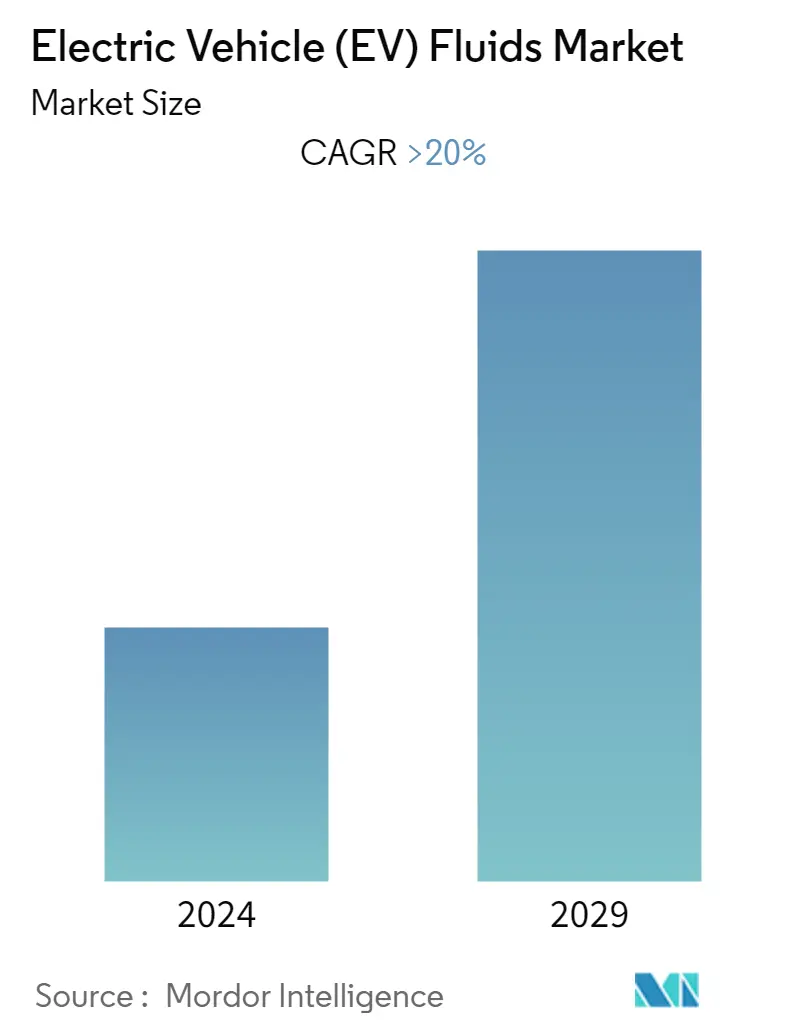Market Size of Electric Vehicle (EV) Fluids Industry

| Study Period | 2019 - 2029 |
| Base Year For Estimation | 2023 |
| Forecast Data Period | 2024 - 2029 |
| Historical Data Period | 2019 - 2022 |
| CAGR | > 20.00 % |
| Market Concentration | Medium |
Major Players_Fluids_Market-Major_Players.webp)
*Disclaimer: Major Players sorted in no particular order |
Electric Vehicle (EV) Fluids Market Analysis
The South American electric vehicle (EV) fluids market is expected to register a CAGR of over 20%, during the forecast period.
The market was hampered by the COVID-19 pandemic, as lockdowns, social distances, and trade sanctions triggered massive disruptions to global supply chain networks. The automotive industry, including sales and manufacturing of electric vehicles,witnessed a decline due to the halt in activities. However, the condition was expected to recover in 2021, which could benefit the market during the forecast period.
- Major factors driving the market studied are the increasing demand for electric vehicles among consumers in Brazil.
- The high cost of purchasing an electric vehicle is expected to hinder the growth of the market studied.
- Increasing government initiatives to promote the sale of EVs is likely to act as an opportunity in the future.
Electric Vehicle (EV) Fluids Industry Segmentation
EV fluids are lubricants that have been designed and developed specifically to suit the needs of electric vehicles. EV fluids keep the electric vehicle's powertrain and transmission system cool. The function of the EV fluid includes heat transfer, lubrication of EV parts, energy loss reduction, and improving the transmission system. The electric vehicle (EV) fluids market is segmented by product type, propulsion type, vehicle type, and geography. By product type, the market is segmented into engine oil, coolants, transmission fluids, greases, and other product types. By propulsion type, the market is segmented into battery electric vehicles (BEVs)), hybrid electric vehicles (HEVs), and plug-in hybrid electric vehicles (PHEVs). By vehicle type, the market is segmented into passenger vehicles, commercial vehicles, and other vehicle types. For each segment, the market sizing and forecasts have been done based on revenue (USD million).
| Product Type | |
| Engine oil | |
| Coolants | |
| Transmission Fluids | |
| Greases | |
| Other Product Types |
| Propulsion Type | |
| Battery Electric Vehicles (BEVs) | |
| Hybrid Electric Vehicles (HEVs) | |
| Plug-in Hybrid Electric Vehicles (PHEVs) |
| Vehicle Type | |
| Passenger Vehicle | |
| Commercial Vehicles | |
| Other Vehicle Types |
| Geography | |
| Brazil | |
| Argentina | |
| Rest of South America |
Electric Vehicle (EV) Fluids Market Size Summary
The South America electric vehicle (EV) fluids market is poised for significant growth, driven by the increasing adoption of electric vehicles, particularly in Brazil. The market experienced setbacks due to the COVID-19 pandemic, which disrupted supply chains and led to a decline in automotive sales and manufacturing. However, recovery was anticipated, with Brazil leading the charge due to its commitment to green logistics and the environmental, social, and governance (ESG) agenda. Government initiatives like the Rota 2030 plan have further bolstered the market by promoting sustainable mobility and providing incentives for the adoption of electric vehicles. This has resulted in a surge in hybrid and battery electric vehicle sales, contributing to the demand for EV fluids, particularly coolants.
The market landscape is partially consolidated, with major players such as Shell plc, Valvoline Global Operations, TotalEnergies, Exxon Mobil Corporation, and CASTROL LIMITED actively participating. These companies are expanding their portfolios to include specialized EV fluids and lubricants, catering to the growing market needs. The introduction of new technologies, such as sulfur-free driveline lubricants, underscores the industry's focus on innovation and adaptation to the evolving automotive landscape. As the region moves towards a more electrified future, the demand for EV fluids is expected to rise, supported by increasing consumer interest and government support for electric vehicle adoption.
Electric Vehicle (EV) Fluids Market Size - Table of Contents
-
1. MARKET DYNAMICS
-
1.1 Drivers
-
1.1.1 Increasing Demand for Electric Vehicles
-
1.1.2 Other Drivers
-
-
1.2 Restraints
-
1.2.1 High Cost of Purchasing Electric Vehicle
-
1.2.2 Other Restraints
-
-
1.3 Industry Value Chain Analysis
-
1.4 Porter's Five Forces Analysis
-
1.4.1 Bargaining Power of Suppliers
-
1.4.2 Bargaining Power of Buyers
-
1.4.3 Threat of New Entrants
-
1.4.4 Threat of Substitute Products and Services
-
1.4.5 Degree of Competition
-
-
-
2. MARKET SEGMENTATION (Market Size in Value)
-
2.1 Product Type
-
2.1.1 Engine oil
-
2.1.2 Coolants
-
2.1.3 Transmission Fluids
-
2.1.4 Greases
-
2.1.5 Other Product Types
-
-
2.2 Propulsion Type
-
2.2.1 Battery Electric Vehicles (BEVs)
-
2.2.2 Hybrid Electric Vehicles (HEVs)
-
2.2.3 Plug-in Hybrid Electric Vehicles (PHEVs)
-
-
2.3 Vehicle Type
-
2.3.1 Passenger Vehicle
-
2.3.2 Commercial Vehicles
-
2.3.3 Other Vehicle Types
-
-
2.4 Geography
-
2.4.1 Brazil
-
2.4.2 Argentina
-
2.4.3 Rest of South America
-
-
Electric Vehicle (EV) Fluids Market Size FAQs
What is the current Electric Vehicle (EV) Fluids Market size?
The Electric Vehicle (EV) Fluids Market is projected to register a CAGR of greater than 20% during the forecast period (2024-2029)
Who are the key players in Electric Vehicle (EV) Fluids Market?
Shell plc, Valvoline Global Operations, TotalEnergies, Exxon Mobil Corporation and CASTROL LIMITED are the major companies operating in the Electric Vehicle (EV) Fluids Market.

